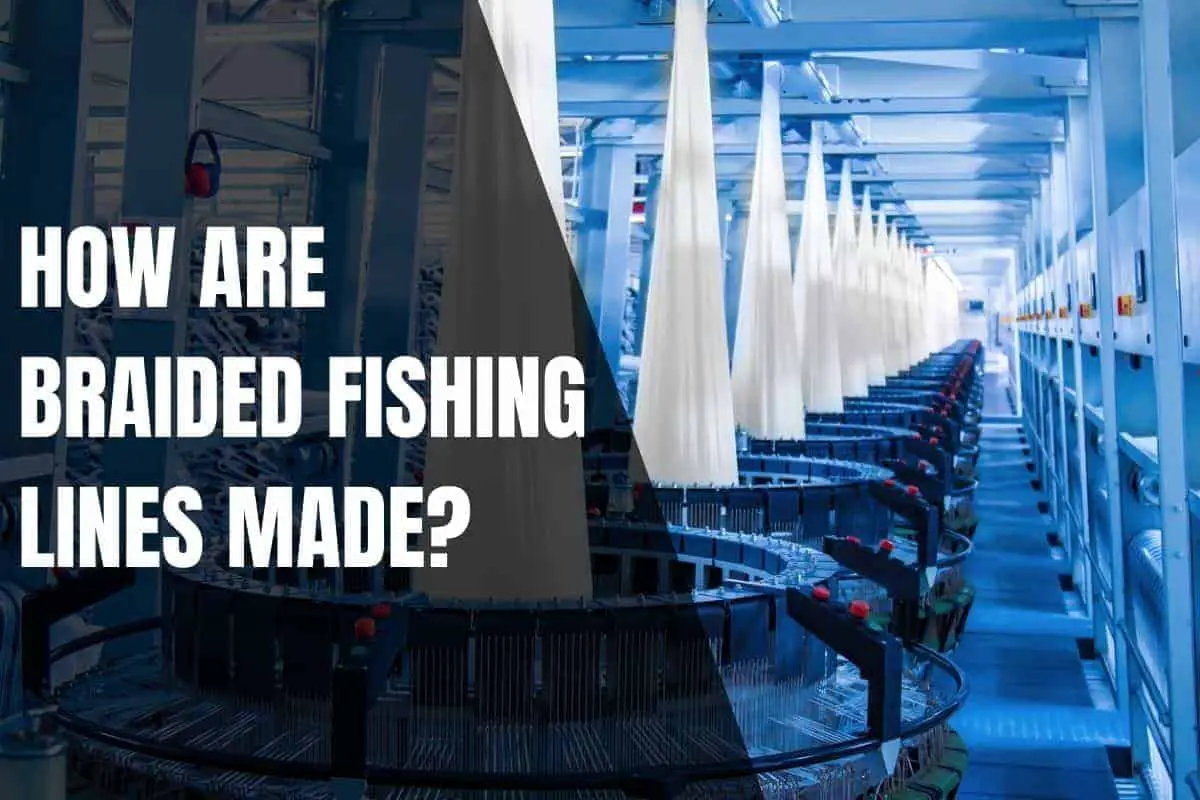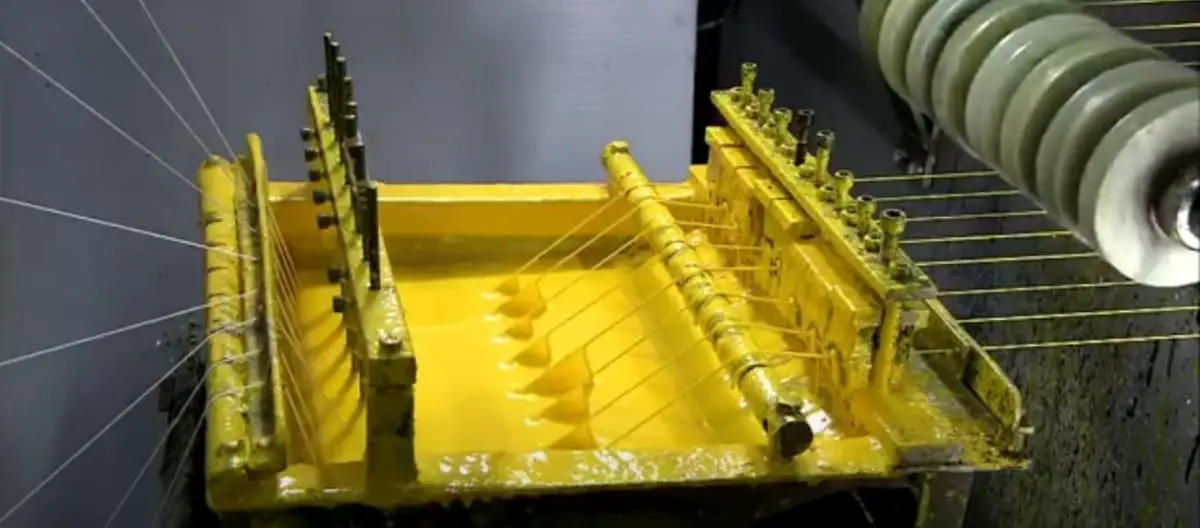Fishing lines have made steady progress over the years. The history of braided fishing lines stretches as far back as biblical times. How we manufacture braided lines today is very different than 100 years. Today, we will be exploring how braided fishing lines are typically made.
Braided fishing lines consist of many microfibers there are tightly twisted together. The manufacturing process is a complex one. The factory uses various machinery working together to produce batches of lines.
There is so much more we need to discuss how they make braided fishing lines. If you want to find out exactly how they make it and what materials are used in the process, this article will have all of that information. Let’s jump into it.

What Is Braided Fishing Line Made Of?
In most cases, you could use any one of these materials in any fishing condition, but some are better than others, and let’s talk about that:
- Nylon: This used to be the most popular material used for braided fishing lines. It provides a perfect balance of strength and stretch at a low cost. If you are looking for an all-around line, Nylon is your best bet.
- Spectra: Many companies use the word Spectra in their marketing because this line is proving to be the most durable with the most extended lifespan compared to other materials. It has an extremely low stretch; however, it is the most costly. Again, it is suited to most conditions.
- Dyneema: This material is extremely close to Spectra in almost every way. The most significant difference is in the stretch, which is virtually non-existent with Dyneema. I do not recommend this line for surf fishing because you will feel every ripple that hits the line. Instead, use Dyneema for calmer waters.
- Dacron: Dacron might be your best bet if you want to do deep-sea fishing for game fish. It does not have the best anti-abrasion qualities making it a tough choice for shallower waters. However, its durability and strength make it perfect for bigger fish and deeper waters.
Those are not the only materials available. However, they are the most popular. Also, companies will continue to experiment with other materials. As the world of synthetic plastics and fibers continues to progress, I assume we will see new additions in the future.
How Is Braided Fishing Line Made: The Manufacturing Process
The manufacturing process for braided fishing lines is complex, made simple with machinery. When it comes to manufacturing braided fishing lines, a critical thing to note is the line needs to stay at a constant tension throughout the process.
Other than that, we can break everything down into steps. So, let’s jump into it.
1. Transferring The Fiber To A Bobbin
Most fishing line companies receive their fiber in large batches. It is not uncommon for fishing companies to use Dacron, Nylon, Spectra, or micro-Dyneema fibers. These fibers are also known as raw materials as they are the building blocks for the finished product.
The process starts with a person preparing the microfibers to be transferred to a bobbin, like a specialized spool. Although not very time-consuming, the process can be tedious as the person needs to thread the fibers through a thin needle.
Once that is complete, a machine takes care of the rest. When transferring the fiber to a bobbin, an engineer will program the machinery to use a constant tension for each bobbin. They will also make sure that the fiber is rolled uniformly for added consistency.
2. The Fibers Are Braided
Most companies use a specialized braiding machine for this process. The bobbins containing the microfibers get placed on the braiding device. Each bobbin is spaced evenly from the next one. Remember, they need to maintain uniformity. Here are a few essential things to note about the braiding process:
- Each braiding machine can hold 8 to 16 bobbins.
- Above the braiding machine is the spool that pulls the braid up while spinning.
- The spool has to rotate constantly to provide constant tension throughout the braid.
- The spool spins at a slow but steady pace.
- The braiding machine and spool work to produce between 14 and 16 yards of line per hour.
That may seem extremely slow, and it is. The longer the line gets braided for, the tighter the braid will be, meaning the stronger the line will end up.
Some companies cannot afford to let the braid spin for too long. So, some braids are not equal to others, and the duration of the braiding process is a significant quality factor.

3. Color Is Added To The Line
There are various methods that braided fishing line companies can use to add color to the product. One approach is to use a mixture of hot water and dye. The mixture gets placed into a pressurized oven along with the braided line.
When the dye heats up under pressure, it manages to seep into the braided line evenly. I like to think of it as almost infusing the line and dye rather than coating it. Other chemicals will sometimes get added to provide a layer of protection around the line.
Another method is to run the fishing line through a resin. Different resins provide different results. The main goal, however, is to strengthen the line. The resin might be mixed with dye to give the fishing line a unique color. Once again, let’s look at a few things to note about the different resins used to coat braided fishing line:
- Silicone is a popular resin to use.
- Most resins are water-based.
- The better the quality of the resin, the more even the coat will be.
- Most resins reduce abrasion, increase strength and improve the handling of the line.
4. Curing The Resin
If a company uses resin to color the fishing line, it will have to be cured. While maintaining a constant tension, the braided line will get pulled through an oven. Different resins require different temperatures so that the oven will be anywhere from 275 degrees Fahrenheit to 350F.
The line gets pulled relatively slowly, and the pace will be maintained so that each part of the braided line gets cured evenly.
5. Transferring The Product Onto A Spool
Each company employs a different method of transferring the braided line onto a retail-ready spool. A spooling machine gets used to speed up the process. Remember, the tension will be constant throughout the process, making it easier for you, the client, to transfer it onto your fishing reel without losing tension.
Once the spools have the right amount of braid, they are packaged in their boxes and put aside for shipping.
Does Braided Fishing Line Go Through Quality Assurance and Testing?
Because the fishing line undergoes a lot of stress while being used, the lines need to be tested thoroughly. This is to make sure that they meet the manufacturer’s standards. In some cases, a third party is in charge of the testing.
A faulty batch could ruin the reputation of the company, and to prevent this from happening, they will put their product through a series of tests, these include:
- Strength Testing
- Stretch
- Breaking Strain
- Knot Strength
- Suppleness
- Submersion
- Temperature
Every fishing tackle company has a different way of testing these variables. Some companies like to have their product tested at random. So, they will grab a few line spools from the factory line for random testing.
If the line fails too many tests, the entire batch will get scrapped. Also, a failed quality assurance test could lead to the product not being classified as the product it intends to be.

Development of New Braid Lines
To ensure that a product stays competitive, companies need to think outside the box. that is where research and development come in. It is hard to say how much money companies such as the Coleman company, owner of PureFishing, spend on R&D.
Research and development is a broad term when talking about braided fishing lines. Every year a company works to improve on its product offering. To do this, an expert will assess possible routes that the company can take to do so.
Something as simple as finding a new resin to improve the handling of the fishing line can take months of trial and error. The company will also try and find the weak points of the existing products as this helps them know where to start with their R&D.
The Best Braided Fishing Line Manufacturers:
Finding the best-braided fishing line manufacturers is not an easy task. It is a highly competitive market that constantly evolves as companies sink more money into research and development. That said, I have narrowed it down for you:
There are many more brands available; however, through personal experience, I cannot recommend these brands enough. Shimano has been a staple in the fishing community for an extremely long time, but brands like KastKing are positively impacting the industry.
Happy Fishing & Tight Lines
